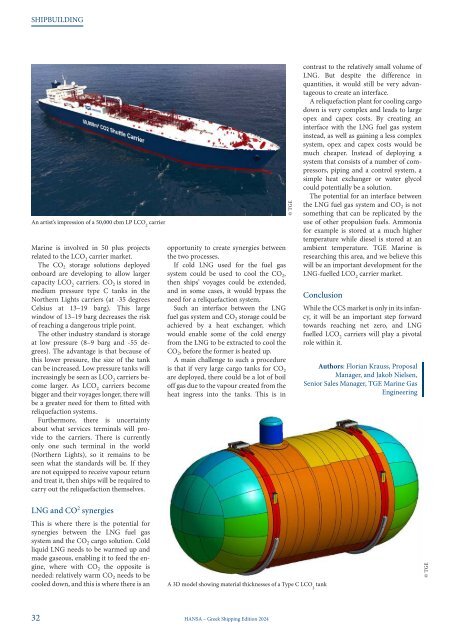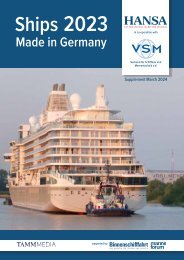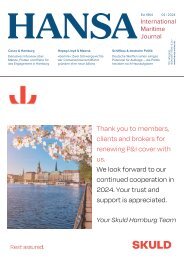HANSA Greek Shipping 2024 Posidonia Edition
SHIPPING: Greece in numbers / Interview Theodore Vokos, Managing Director, Posidonia Exhibitions / Interview Elias Kariambas, Vice President, Regional Business Development, Greece / Interview Michael Suhr, Senior Vice President and Regional Director North Europe at Korean Register (KR) / Greek shipowners on the way to Net Zero / Greek company’s strong in Capesize sector / Personal support as a USP SHIPBUILDING: Welcome to Posidonia 2024 / Setting sail for success in Greek market / Interview Jörg Karthaus, Head of Sales, Pleiger Maschinenbau / A data driven crystal ball / LNG fuelled LCO2 carriers: going for growth / 75 years of MMG Propeller – an eventful success story / Interview Lars Greitsch, CEO at Mecklenburger Metallgus (MMG)
SHIPPING: Greece in numbers / Interview Theodore Vokos, Managing Director, Posidonia Exhibitions / Interview Elias Kariambas, Vice President,
Regional Business Development, Greece / Interview Michael Suhr, Senior Vice President and Regional Director North Europe at Korean Register (KR) / Greek shipowners on the way to Net Zero / Greek company’s strong in Capesize sector / Personal support as a USP
SHIPBUILDING: Welcome to Posidonia 2024 / Setting sail for success in Greek market / Interview Jörg Karthaus, Head of Sales, Pleiger Maschinenbau / A data driven crystal ball / LNG fuelled LCO2 carriers: going for growth / 75 years of MMG Propeller – an eventful success story / Interview Lars Greitsch, CEO at Mecklenburger Metallgus (MMG)
You also want an ePaper? Increase the reach of your titles
YUMPU automatically turns print PDFs into web optimized ePapers that Google loves.
SHIPBUILDING<br />
An artist’s impression of a 50,000 cbm LP LCO 2<br />
carrier<br />
Marine is involved in 50 plus projects<br />
related to the LCO 2<br />
carrier market.<br />
The CO 2 storage solutions deployed<br />
onboard are developing to allow larger<br />
capacity LCO 2<br />
carriers. CO 2 is stored in<br />
medium pressure type C tanks in the<br />
Northern Lights carriers (at -35 degrees<br />
Celsius at 13–19 barg). This large<br />
window of 13–19 barg decreases the risk<br />
of reaching a dangerous triple point.<br />
The other industry standard is storage<br />
at low pressure (8–9 barg and -55 degrees).<br />
The advantage is that because of<br />
this lower pressure, the size of the tank<br />
can be increased. Low pressure tanks will<br />
increasingly be seen as LCO 2<br />
carriers become<br />
larger. As LCO 2<br />
carriers become<br />
bigger and their voyages longer, there will<br />
be a greater need for them to fitted with<br />
reliquefaction systems.<br />
Furthermore, there is uncertainty<br />
about what services terminals will provide<br />
to the carriers. There is currently<br />
only one such terminal in the world<br />
(Northern Lights), so it remains to be<br />
seen what the standards will be. If they<br />
are not equipped to receive vapour return<br />
and treat it, then ships will be required to<br />
carry out the reliquefaction themselves.<br />
opportunity to create synergies between<br />
the two processes.<br />
If cold LNG used for the fuel gas<br />
system could be used to cool the CO 2 ,<br />
then ships’ voyages could be extended,<br />
and in some cases, it would bypass the<br />
need for a reliquefaction system.<br />
Such an interface between the LNG<br />
fuel gas system and CO 2 storage could be<br />
achieved by a heat exchanger, which<br />
would enable some of the cold energy<br />
from the LNG to be extracted to cool the<br />
CO 2 , before the former is heated up.<br />
A main challenge to such a procedure<br />
is that if very large cargo tanks for CO 2<br />
are deployed, there could be a lot of boil<br />
off gas due to the vapour created from the<br />
heat ingress into the tanks. This is in<br />
© TGE<br />
contrast to the relatively small volume of<br />
LNG. But despite the difference in<br />
quantities, it would still be very advantageous<br />
to create an interface.<br />
A reliquefaction plant for cooling cargo<br />
down is very complex and leads to large<br />
opex and capex costs. By creating an<br />
interface with the LNG fuel gas system<br />
instead, as well as gaining a less complex<br />
system, opex and capex costs would be<br />
much cheaper. Instead of deploying a<br />
system that consists of a number of compressors,<br />
piping and a control system, a<br />
simple heat exchanger or water glycol<br />
could potentially be a solution.<br />
The potential for an interface between<br />
the LNG fuel gas system and CO 2 is not<br />
something that can be replicated by the<br />
use of other propulsion fuels. Ammonia<br />
for example is stored at a much higher<br />
temperature while diesel is stored at an<br />
ambient temperature. TGE Marine is<br />
researching this area, and we believe this<br />
will be an important development for the<br />
LNG-fuelled LCO 2<br />
carrier market.<br />
Conclusion<br />
While the CCS market is only in its infancy,<br />
it will be an important step forward<br />
towards reaching net zero, and LNG<br />
fuelled LCO 2<br />
carriers will play a pivotal<br />
role within it.<br />
Authors: Florian Krauss, Proposal<br />
Manager, and Jakob Nielsen,<br />
Senior Sales Manager, TGE Marine Gas<br />
Engineering<br />
LNG and CO 2 synergies<br />
This is where there is the potential for<br />
synergies between the LNG fuel gas<br />
system and the CO 2 cargo solution. Cold<br />
liquid LNG needs to be warmed up and<br />
made gaseous, enabling it to feed the engine,<br />
where with CO 2 the opposite is<br />
needed: relatively warm CO 2 needs to be<br />
cooled down, and this is where there is an<br />
A 3D model showing material thicknesses of a Type C LCO 2<br />
tank<br />
© TGE<br />
32 <strong>HANSA</strong> – <strong>Greek</strong> <strong>Shipping</strong> <strong>Edition</strong> <strong>2024</strong>

















